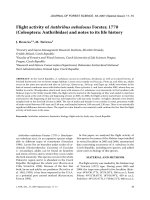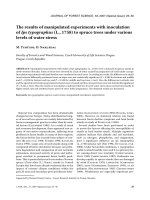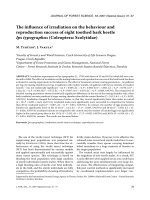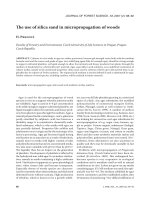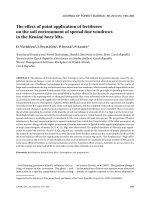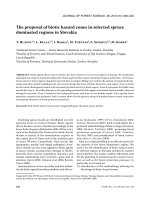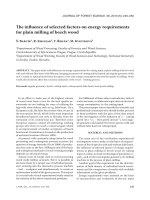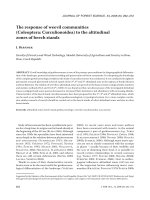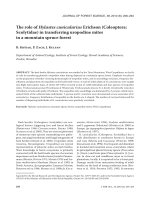Báo cáo lâm nghiệp: " The influence of different overstory removal on planted spruce and several broadleaved tree species: Survival, growth and pine weevil damage during three years" pps
Bạn đang xem bản rút gọn của tài liệu. Xem và tải ngay bản đầy đủ của tài liệu tại đây (1001.46 KB, 8 trang )
237
Ann. For. Sci. 62 (2005) 237–244
© INRA, EDP Sciences, 2005
DOI: 10.1051/forest:2005015
Original article
The influence of different overstory removal on planted spruce
and several broadleaved tree species: Survival, growth and pine weevil
damage during three years
Magnus LÖF
a
*, Robert PAULSSON
b
, Dan RYDBERG
c
, Nils Torkel WELANDER
a
a
Swedish University of Agricultural Sciences, Southern Swedish Forest Research Centre, PO Box 49, 230 53 Alnarp, Sweden
b
PO Domaregatan 7C, 256 59 Helsingborg, Sweden
c
Regional Forestry Board South Götaland, PO Box 234, 291 23 Kristianstad, Sweden
(Received 5 February 2004; accepted 7 July 2004)
Abstract – The influence of different overstory removal on herbivory by the pine weevil to seedlings was studied in a field experiment. Four
overstory treatments with middle aged Norway spruce in combination with or without insecticide treatments were applied. Seedlings of the
following seven tree species were planted in each of the four blocks: Acer platanoides L., Fagus sylvatica L., Fraxinus excelsior L., Picea abies
L. (Karst.), Prunus avium L., Quercus robur L. and Tilia cordata Mill. The seedlings were monitored through the 2001–2003 growing seasons.
Highest survival was found among seedlings planted in the overstory treatments with 15 and 20% light in the understory, whereas best diameter
growth in seedlings was found in the clearcut. Overstory trees of Norway spruce decreased herbivory from pine weevil considerably among
underplanted seedlings, and the pine weevils fed significantly more on planted Norway spruce seedlings than on all broadleaved tree species.
The following rough preference order was obtained: (1) Norway spruce >> (2) beech and oak > (3) ash, cherry, lime and maple. The influence
from the insecticide treatment was minor. Therefore, during the conversion of Norway spruce monocultures into mixed species stands using
overstories, the use of insecticides against pine weevil is not needed.
forest restoration / forest transformation / insect damage / regeneration / shelterwood
Résumé – Influence de différentes suppressions de l’étage dominant sur des plants d’épicéas et de plusieurs espèces de feuillus : survie,
croissance et dégâts par le charançon des pins pendant trois ans. L’influence de différentes suppressions de l’étage dominant sur
l’herbivorie du charançon des pins sur des jeunes plants a été étudiée dans une expérience sur le terrain. Quatre traitements de l’étage dominant
sur des épicéas de Norvège d’âge moyen, combinés ou non avec des traitements insecticides, ont été appliqués. Des jeunes plants des sept
espèces d’arbres suivantes ont été plantés dans chacun des quatre blocs: Acer platanoides L., Fagus sylvatica L., Fraxinus excelsior L., Picea
abies L. (Karst.), Prunus avium L., Quercus robur L. et Tilia cordata Mill. Les plants ont été suivis durant les saisons de croissance 2001–2003.
Le plus haut taux de survie a été trouvé chez les plants plantés dans les traitements de l’étage dominant avec 15 et 20 % de lumière dans le sous-
étage, alors que la meilleure croissance du diamètre chez les plants a été trouvée dans la coupe à blanc. Les arbres à étage dominant de l’épicéa
de Norvège ont diminué considérablement l’herbivorie du charançon des pins au niveau des plants sous-plantés et les charançons des pins se
sont significativement plus nourris sur les plants d’épicéas de Norvège que sur toutes les espèces de feuillus. L’ordre de préférence sommaire
suivant a été obtenu : (1) épicéa de Norvège >> (2) hêtre et chêne > (3) frêne, cerisier, tilleul et érable. L’influence du traitement insecticide a
été mineure. C’est pourquoi, durant la conversion des monocultures d’épicéas de Norvège en groupes d’espèces mixtes utilisant les étages
dominants, l’utilisation d’insecticides contre le charançon des pins n’est pas nécessaire.
restauration des forêts / transformation des forêts / dégâts d’insectes / régénération / forêt de protection
1. INTRODUCTION
The pine weevil (Hylobius abietis L.) is a major problem for
reforestation with seedlings of conifers throughout Europe and
Asia [3, 9]. The widely used silvicultural system in Europe with
monocultures of conifers and clear-cutting probably produces
optimal breeding conditions for the weevil, since the larvae
develop in the stumps and roots of dying and dead coniferous
trees [2]. The adult pine weevil feeds on the bark of young seed-
lings shortly after they have been planted and may cause the
death of up to 80% of coniferous seedlings planted without pro-
tective measures following clear-cutting of Norway spruce (Picea
abies L. Karst.) and Scots pine (Pinus sylvestris L.) [19, 28].
The use of insecticides (e.g. permethrin) for seedling pro-
tection usually keeps seedling mortality at acceptable levels
and has therefore been widely used [9, 19]. However, its use
* Corresponding author:
Article published by EDP Sciences and available at or />238 M. Löf et al.
may become prohibited for environmental reasons, something
which may cost e.g. Swedish forestry enormous sums of money
in lost growth and failed plantations [32]. Alternative control
methods, e.g. a fallow period of two to three years, mechanical
site preparation, protective collars, protective stockings and the
provision of shelterwood trees, have been proposed but have
not prevented all damage [9, 22].
Forest restoration has become increasingly common around
the globe and the conversion of these anthropogenous conifer-
ous forests, which were planted in Europe from the end of the
18th century, into natural broad-leaved forests is one type of
restoration practice currently being used [25, 26, 35]. It is thus
getting more and more common to convert stands through the
planting of broadleaves following clear-cutting of conifers or
under coniferous shelterwoods [10, 14, 17, 18]. The latter
method has advantages compared to clear-cutting through less
interference from ground vegetation, less frost damage to
planted seedlings and less leakage of nutrients to the ground
water [7, 24], although the residual stand at some sites stands
a great risk of blowing down [26]. However, little research has
been done, which supports forest conversion through the plant-
ing of broadleaves under coniferous shelterwoods.
Feeding by the pine weevil on coniferous seedlings has been
studied in detail [2, 3, 9, 27]. However, pine weevil feeding on
broadleaved seedlings is less investigated. Although it is
known that adult pine weevils may feed on seedlings of various
broadleaved species [8, 12, 13, 23, 30], there are almost no
quantitative data on the pine weevil’s feeding behavior and
preferences during forest conversion using coniferous shelter-
woods [11]. Knowledge in this area may be important to forest
conversion activities, but also in order to find alternatives to the
use of insecticides when these may become prohibited.
This study investigated above-ground pine weevil herbivory
to seedlings of six different broadleaved species and to Norway
spruce planted under different densities of shelterwood trees of
Norway spruce. The specific objectives were: (1) to evaluate
the influence of different overstory removal on pine weevil
feeding behaviour; (2) to examine the effect of permethrin in
relation to overstory removal; and (3) to evaluate the feeding
preferences and the impact of pine weevils on planted broad-
leaved and Norway spruce seedlings.
2. MATERIALS AND METHODS
2.1. Study site, climate and experimental design
The experiment was established in 2001 at a site dominated by Nor-
way spruce in southern Sweden and located near Åkulla, about 20 km
east of Varberg (57º 05’ N, 13º 04’ E, 120 m above sea level). The
site is fresh, the soil texture is sandy moraine, and the ground vegeta-
tion is a grass type [5]. The site index for Norway spruce, i.e. the dom-
inant height at an age of 100 years, is 32 m and the Norway spruce
forest was 40 years old when the experiment was established.
The 30-year-mean temperature in July and January (climate station
located 20 km west of the experiment) was 16.2 °C/–1.3 °C and the
30-year-mean annual precipitation was 738 mm [1]. Compared to the
30-year mean, the weather was normal from May to September in
2001–2003 with some exceptions. It was warmer than normal in
August 2002 and from July to September 2003. There was a lot of pre-
cipitation in June 2002 and less precipitation than normal in September
2002 and in August and September 2003, respectively [1].
In January 2001, clear-cutting and thinning was done in order to
establish the different overstory treatments. The experimental design
was randomized blocks with sub-plots (split-split plots). Four blocks
were laid out with four overstory treatments in each block. Stand data
and light environments in 2003 are presented in Table I. The light lev-
els were approx. 5, 15, 20 and 100 per cent, respectively, of full light.
Each overstory treatment was approx. 20 × 20 m with a 10-m buffer
zone in each direction. Three blocks were laid out close to each other,
whereas the fourth block was laid out approx. 400 m from the others.
Each overstory treatment and block consisted of two insecticide
treatments (sub-plots), each sub-plot including seven rows of different
tree species. The insecticide treatments were: No insecticide treatment
and insecticide treatment (permethrin). The latter seedlings were
treated with insecticide (permethrin, 0.5% active ingredient) on the
lower 10 cm of the stem in June 2001, 2002 and 2003. The seven tree
species were planted in species-separated rows of 20 seedlings in each
row (sub sub-plots). Thus, each overstory treatment and block con-
sisted of 14 rows of seedlings. The tree species were ash, beech, lime,
Norway spruce, maple, oak and wild cherry (see plant materials
below). In May 2001, planting was carried out manually using a plant-
ing spade. Planting was done with a distance of 1 m between seedlings
and 1.5 m between rows. All blocks were fenced against large herbiv-
ores.
This long-term experiment was established with two purposes:
Firstly, to compare the effect of above-ground herbivory from Pine
weevils on early growth and survival in different tree species. Sec-
ondly, to compare the long-term effects of different overstory densities
on the survival, growth and wood quality in various under-planted tree
species. This paper focuses on the influence of pine weevil during the
first three years following planting. In order to allow comparisons with
other studies, background data on the recolonization of ground vege-
tation and the diameter growth in seedlings are also reported.
2.2. Plant materials
Bare-rooted seedlings of ash (Fraxinus excelsior L.) (2/0) (Bill-
ingen, Sweden), beech (Fagus sylvatica L.) (2/0) (Häckeberga, Swe-
den), lime (Tilia cordata Mill.) (1/1) (Northern Germany), maple
(Acer platanoides L.) (2/0) (Poland), Norway spruce (Picea abies L.
(Karst.)) (2/0) (Vitebsk Polots, White Russia), oak (Quercus robur L.)
(2/2) (Poland) and wild cheery (Prunus avium L.) (1/0) (Helsingborg,
Sweden) were used. Bare-rooted seedlings were obtained from differ-
ent nurseries in southern Sweden. Root undercutting at a depth of
approx. 15 cm was done on broadleaved seedlings in the nurseries in
the middle of the first growing season.
2.3. Data collection
The photosynthetic photon flux density (PPFD) was measured on
ten locations per overstory treatment and block (LI-190SA, LiCor Inc.,
Table I. Stand data and light environments at Åkulla in 2003. The
four different overstory treatments are referred to based on their
approximate relative light level at 1.5 m above ground. Mean ± SE.
Overstorey treatment Stems per hectare Light, % of full light
L5 994 ± 47 5 ± 1
L15 538 ± 24 15 ± 3
L20 294 ± 33 20 ± 3
L100 0 100
Article published by EDP Sciences and available at or />Influence of different overstory removal 239
NE, USA) above herbaceous vegetation (approx. 1.5 m). Measurements
were done in two blocks at the end of June and in the two remaining
blocks at the end of August, 2003. On each occasion, the sky was clear
and the measurements were made between 11.00 h and 13.00 h.
The seedling diameter at ground level was measured on all living
seedlings at the beginning of October in 2001, 2002 and 2003. At the
same time, the percentage of vegetation cover was estimated from
above the seedlings in 40-cm radius plots close to all seedlings and
assigned to one of 11 categories, where 0 = 0%, 1 = 1–11%, etc., 10 =
91–100% vegetation cover. All herbaceous vegetation, naturally
regenerated tree seedlings and bushes were included in the estimates,
but mosses were not.
Following growth measurements, estimations of above-ground
Pine weevil herbivory were done on all living seedlings. The degree
of debarking on the seedling stems as caused by the pine weevil was
recorded using a scale with 11 levels, where 0 = 0%, 1 = 1–11%, etc.,
10 = 91–100% debarking. The whole seedling stem, from ground level
to top of seedlings, was used in the estimates. Similar methods have
been used in several other studies (e.g. [4, 6, 19, 31]). Old and new
herbivory were separated using records of old herbivory and only new
herbivory was recorded on each occasion. In order to minimize sub-
jective assessment [4], all visual estimates were done using an elabo-
rate protocol for these measurements. In addition, all visual estimates
were done by the same persons, except in 2003.
Other agents of seedling damage than pine weevil, e.g. frost, fungi,
waterlogging, browsing from hare and voles, other insects than pine
weevil, plant handling and unknown damage, were also observed for
each living seedling at each inventory.
2.4. Calculations and statistical analysis
The mean frequency of seedlings with feeding scars from pine wee-
vil was calculated for the three years using data from the annual inven-
tories and the number of living seedlings. In addition, the cumulative
degree of damage from pine weevil in all living seedlings was calcu-
lated in 2003 using the annual inventories.
The general linear model (GLM) procedure for the analysis of var-
iance was used to perform statistical tests on seedling survival, the per-
centage of seedlings with herbivory from pine weevil and cumulative
herbivory following the growing season in 2003 after calculating treat-
ment averages (SAS Institute Inc., Cary, NC, USA). A randomized
block design with split-split plots was used. In addition, each insecti-
cide treatment within the different overstory treatments was analyzed
using a randomized block design. Before the survival rates and the per-
centage of seedlings with herbivory were analyzed, frequencies were
transformed according to Zar [34] using the formula:
p’= ½ (arcsin (X/(n+1))
1/2
+ arcsin ((X + 1)/(n+1))
1/2
) (1)
where p’ is the transformed frequency, X denotes the number of living
seedlings (or number of living seedlings with herbivory) at the end of
the experiments, and n is the number of planted seedlings at the begin-
ning of the experiment. Where significant F values occurred, the anal-
ysis of variance was followed by Tukey’s multiple range test. In the
comparisons, p < 0.05 was considered as significant.
3. RESULTS
3.1. Re-colonization of ground vegetation
Three growing seasons after planting in 2001, the cover of
ground vegetation near the seedlings was about 80% for the
L100 treatment (Fig. 1). In the L20 treatment, the cover of
ground vegetation increased from about 20% in 2001 to 30%
in 2003. In the L15 and L5 treatments, the cover of ground veg-
etation did not show a positive development.
3.2. Survival and growth in seedlings
After three growing seasons there was higher (p < 0.05) sur-
vival in the L20 and L15 treatments – ranging from approx.
80% to 100% – than in the L100 and L5 treatments (Fig. 2). In
addition, there was lower (p < 0.05) survival in the L5 treat-
ment than in the L100 treatment. For a majority of the seedlings
that died, mortality occurred after the second growing season,
except in the L5 treatment where most mortality occurred after
the first growing season. No effect of the insecticide treatment
was found on seedling survival. In the L100 treatment, there
was no difference in seedling survival between tree species
when the seedlings were not treated with permethrin. However,
when the seedlings were treated with permethrin, ash and maple
had lower (p < 0.05) survival than beech and cherry. In the L20
and L15 treatments, there was no difference between species
when the seedlings were treated with permethrin. However,
when the seedlings were not treated with permethrin, maple had
lower (p < 0.05) survival than lime in the L20 treatment and oak
had lower (p < 0.05) survival than beech, lime and cherry in the
L15 treatment. For both insecticide treatments in the L5 treat-
ment, oak had less than 40% survival, which was much lower
(p < 0.05) than in all other tree species except Norway spruce.
Here, Norway spruce had lower (p < 0.05) survival than beech,
lime, ash and cherry when it was not treated with insecticide.
The largest increase in diameter was found in the L100 treat-
ment followed by the L20, L15 and L5 treatments (Fig. 3). In
the L100 treatment, beech, oak, lime, cherry and spruce had a
higher diameter growth than maple and ash and reached a diam-
eter of between 13 and 20 mm after three growing seasons.
When the experiment was initiated, all tree species had a diam-
eter at ground level of between 5 and 8 mm. There was no ten-
dency for differences in diameter growth between the two
insecticide treatments.
3.3. Damage by the pine weevil
After three growing seasons, there was a clear effect
(p < 0.001) of both the overstory treatment and the insecticide
treatment on the number of seedlings with feeding scars from
Figure 1. Re-colonization of herbaceous vegetation close to the see-
dlings at the end of 2001, 2002 and 2003 in four overstory treatments.
For a description of treatments, see text. Mean ± SE.
Article published by EDP Sciences and available at or />240 M. Löf et al.
pine weevil (Fig. 4). However, there was interaction (p < 0.05)
between overstory and insecticide treatment and permethrin
only had a significantly positive effect (p < 0.05) in the L20 and
L15 treatments. In both insecticide treatments, the L100 treatment
had more (p < 0.05) seedlings with feeding scars than the other
overstory treatments. The L5 treatment had less (p <0.05)
Figure 2. Mean percentage of surviving seedlings in four overstory densities with and without permethrin treatment at the end of the growing
seasons in 2001–2003 and following planting in the spring of 2001. For a description of the treatments, see text. 2003 (white), 2002 (pattern)
and 2001 (light grey). Mean ± SE.
Figure 3. Mean seedling stem diameter at ground level in four overstory densities with and without permethrin treatment in three years. For a
description of the treatments, see text. Mean ± SE.
Article published by EDP Sciences and available at or />Influence of different overstory removal 241
seedlings with feeding scars than the L20 and L100 treatments.
Three years after planting, almost 100% of the Norway spruce
seedlings in the L100 treatment had feeding scars if they had
not been treated with permethrin, something which was more
(p < 0.05) than all other tree species. Here, more (p <0.05)
beech and oak seedlings had feeding scars than in other broad-
leaved species, where few seedlings were touched. Even when
treated with permethrin, approx. 50% of the Norway spruce
seedlings had feeding scars in the L100 treatment, and signif-
icantly more (p < 0.05) than in maple. In the L20 treatment also,
approx. 50% of the Norway spruce seedlings had feeding scars
if they had not been treated with permethrin. This was more
(p < 0.05) than for all broadleaved species except beech. When
treated with permethrin, there were no differences between the
tree species in the L20 treatment. In the L5 and L15 treatments,
there were no differences between tree species concerning the
number of seedlings with feeding scars from pine weevil, irre-
spective of insecticide treatment. A majority of the seedlings
were attacked during the second growing season, except for
Norway spruce in the L100 treatment, where almost all seed-
lings were touched already in the first growing season if they
were not treated with permethrin.
There was a significant effect (p < 0.001) for both overstory
treatment and insecticide treatment on cumulative herbivory by
the pine weevil after three growing seasons (Fig. 5). However,
there was significant interaction (p < 0.01) between overstory
and insecticide treatment and there was only an effect
(p < 0.05) of insecticide treatment in the L100 and L20 treat-
ments. For both insecticide treatments, the L100 treatment had
higher (p < 0.05) cumulative herbivory compared to the L20,
L15 and L5 treatments. In the L100 treatment, there was higher
(p < 0.05) cumulative herbivory on Norway spruce than on all
other tree species when the seedlings were not treated with per-
methrin, and the values corresponded to about 30% debarking
of the stem over three years. Other species had less than 10%
debarking of the stem. Similar results were found for the L20
treatment, although there was no difference between Norway
spruce and beech. There was no difference in cumulative her-
bivory between tree species when the seedlings were treated
with permethrin.
4. DISCUSSION
Following three growing seasons and except for the L5 treat-
ment, high seedling survival was found in the present study.
Something that shows that high seedling survival in several tree
species can be achieved when using planting under shelter-
woods of Norway spruce as a tool for forest conversion. For
ash and wild cherry, the high survival in L5 treatment was unex-
pected. According to Lüpke et al. [10], the latter species are
grouped together with oak as only slightly shade tolerant. How-
ever, low light may cause low growth and high mortality in the
long run. Both ash and wild cherry had a tendency of less diam-
eter growth in the various shelterwoods compared to the shade
tolerant beech and lime. As expected, diameter growth in seed-
lings increased with light intensity in the present study.
When the Norway spruce seedlings in the L100 treatment
were not treated with permethrin, about 90% and 95% of them
had feeding scars from pine weevil following the first and second
Figure 4. Mean percentage of living seedlings with feeding scars. Seedlings without permethrin treatment (control) and seedlings with per-
methrin treatment (permethrin). For description of treatments see text.
Article published by EDP Sciences and available at or />242 M. Löf et al.
growing season, respectively. The attack rate is in line with
other studies performed in clear-cuts without site preparation
in southern Sweden [28]. After three growing seasons, about
30% of the stem was debarked on surviving Norway spruce
seedlings (3.0 in the ranking system used), something which is
also in line with previous research [19].
About 85% survival was found in Norway spruce seedlings
after three growing seasons. This is a higher survival and in con-
trast with results reported in earlier studies [19, 28]. There is
often a positive linear relationship between the number of
attacked seedlings and mortality due to pine weevil [4]. How-
ever, in the present study, seedlings with relatively large diameter
were used. The seedling diameter at ground level in Norway
spruce increased from 8 to 17 mm after the first and third grow-
ing season, respectively. Most seedlings of Norway spruce were
also attacked during the first growing season. Much higher
mortality can be expected when smaller seedlings are used [22,
23]. Similar mortality has been found when large containerized
Norway spruce seedlings with a diameter of 8 to 11 mm were
used for planting [31]. Thus, the degree of damage from pine
weevil was probably normal during this study.
The present study shows that herbivory by the pine weevil
was strongly reduced when overstory trees were present and
herbivory decreased with increased overstory density. Similar
results have been found by others when using Scots pine as
overstory tree [29]. Thus, leaving overstory trees of Norway
spruce seems to be an effective silvicultural method in order to
protect seedlings from pine weevil damage. However, in line
with previous research, all damage was not prevented [11, 22].
It has been demonstrated that herbivory from pine weevil
will be considerably reduced if the overstory density of Scots
pine is greater than 80–160 stems per ha [29]. In the present
study, the density of different overstory treatments ranged from
294 to 994 stems per ha. Thus, the test plots probably had exces-
sive protection from pine weevil. However, it is still necessary
to investigate what overstory density of Norway spruce is actu-
ally needed for protection.
Various ideas have been put forward to answer the question
of why seedlings planted under overstorys show lower levels
of damage from pine weevil. Since pine weevil damage nor-
mally is more severe in clear-cuts, either larger pine weevil pop-
ulations or climatic conditions may be responsible. However,
resent research has shown that the density of pine weevil pop-
ulations is the same in shelterwoods as in clear-cuts [15]. Fur-
thermore, there is no correlation between climatic variables
such as global radiation or soil temperature and pine weevil
damage when experiments have been made close to forest
edges [16]. The pine weevil may feed on fresh coniferous twigs,
in the crowns of coniferous trees and on living tree roots [9, 20].
Therefore, it is most likely that the overstory trees act as an
alternative food source for the pine weevil [16]. It has also been
indicated that herbivory from pine weevil increases when the
seedlings have contact with the ground vegetation [21]. This is
in line with the present study, since the overstory treatments
resulted in reduced ground vegetation.
In the present study, there was no effect of insecticide (per-
methrin) treatments on seedling growth and survival, not even
in the L100 treatment where most herbivory from pine weevil
Figure 5. Mean cumulative herbivory by pine weevil in living seedlings after three growing seasons. Seedlings without permethrin treatment
(control) and seedlings with permethrin treatment (permethrin). 1 = 10%, 2 = 20% and 3 = 30% etc. means debarked area of the stem over three
years. For description of measurements see text. For a description of the treatments, see text.
Article published by EDP Sciences and available at or />Influence of different overstory removal 243
occurred. This is in contrast with several other studies [11, 19,
22, 29]. Insecticide treatment had a positive effect on the
number of seedlings with feeding scars and on cumulative her-
bivory. However, there was an interaction between overstory
treatment and insecticide treatment for the latter variables,
something which was probably a result of decreasing herbivory
with an increased density of overstory trees. However, the gen-
eral effect of the insecticide treatment was less effective than
in comparable studies [11, 19, 22, 29]. In the latter studies,
either a more intensive insecticide treatment was used or
smaller seedlings. Furthermore, in the present study many tree
species were affected by pine weevil to a small extent, irrespec-
tive of treatment and this may have masked the effect from the
insecticide treatment (see discussion below). In addition, the
effect of the permethrin treatment is known to vary greatly
between different years [22]. For oak and Norway spruce seed-
lings in the L5 treatment, a tendency for lower survival was
found when seedlings were not treated with insecticide.
Besides pine weevils, however, other insect damage from Stro-
phosoma melanogrammum, Otiorhynchus scaber and Hylastes
cunicularius was observed. Especially for Norway spruce seed-
lings, the latter insects made damage in the L5 treatment.
Pine weevil fed much more on Norway spruce seedlings than
on broadleaved seedlings. Similar results have been reported
earlier, both from laboratory studies and field experiments [8,
11, 12, 23]. Differences between tree species were only found
in the treatment where no overstory trees were present and in
the treatment which resulted in approx. 20% relative light at
seedling level. From these treatments and based on the number
of seedlings with feeding scars and the cumulative degree of
debarking of the stems, the following rough preference order
was obtained: (1) Norway spruce >> (2) beech and oak > (3)
ash, cherry, lime and maple. This is in accordance with previous
research [11, 12, 23]. Earlier studies have shown that the stem
diameter of attacked seedlings influences survival and that fast-
growing seedlings show lower levels of pine weevil damage
[31]. Therefore, the preference order depends somewhat on the
growth rates in seedlings. In this study, however, the diameter
growth of various species was relatively similar, although
maple and ash showed less growth in diameter compared to the
other species.
In many cases, floral diversity has been shown to reduce pest
problems and mixtures of tree species has been advocated as a
measure in order to avoid damage [33]. For the establishment
of plantations, researchers have discussed the hypothesis that
broadleaved seedlings may act as feeding depressants for the
pine weevil when coniferous and broadleaved seedlings are
planted in mixtures and that it may be an alternative way to control
damage [8]. Under laboratory conditions, the latter researchers
found less feeding on twigs of Scots pine when the pine weevil
also had access to twigs of ash. The results from the present
study and from previous experiments [12] do not support this
hypothesis. The attack rates and the degree of debarking were
normal on Norway spruce seedlings when they were planted in
mixtures with various broadleaved seedlings. However, Leather
et al. [8] were working with small distances in the laboratory
and in the present study the different tree species were not
planted closer than 1.5 m from each other.
The pine weevil is one of the most serious pests of planta-
tions in Europe and several management implications are
apparent from this study. Firstly, when seedlings with relatively
large diameter are used, seedling mortality due to pine weevil
can be kept at an acceptable level. Secondly, overstory trees of
Norway spruce will decrease herbivory from pine weevil con-
siderably among underplanted seedlings, and herbivory
decreases with increased amounts of overstory trees. There-
fore, the use of overstories may be one alternative method to
control pine weevil damage. Furthermore, one may also plant
broadleaved seedlings instead of coniferous seedlings. Since
pine weevil herbivory on broadleaved seedlings was of little
importance, the use of costly insecticides then does not seem
to be required during forest conversion. Finally, it is not pos-
sible to reduce pine weevil herbivory to Norway spruce using
broadleaved seedlings by mixing coniferous and broadleaved
seedlings.
Acknowledgements: We appreciate the assistance of Per-Olof
Erlandsson, Sven Nilsson, Gustav Fredriksson and Gunnar Isacsson
from the Regional Forestry Board South Götaland. Our thanks also to
Christer Jacobsson and Tove Vollbrecht for their help with field work,
and to Nina Eriksson for linguistic improvement. Financial support
was received from the Lidellska foundation, the Royal Swedish Acad-
emy of Agriculture and Forestry and the Swedish Research Council
for Environment, Agricultural Sciences and Spatial Planning.
REFERENCES
[1] Anonymous, Väder och vatten. Swedish meteorological and hydro-
logical institute (SMHI), Norrköping, Sweden, 2001–2003.
[2] Christiansen E., Gransnutebillens økologi og forstlige betydning,
Tidsskr. Skogsbr. 79 (1971) 245–262.
[3] Eidmann H.H., Hylobius Schönh, in: Schwenke W. (Ed.), Die
Forstschädlinge Mitteleuropas, Vol. 2, Paul Parey, Hamburg, 1974,
pp. 275–293.
[4] Eidmann H.H., Lindelöw Å., Estimates and measurements of pine
weevil feeding on conifer seedlings: Their relationships and appli-
cation, Can. J. For. Res. 27 (1997) 1068–1073.
[5] Hägglund B., Lundmark J E., Site index estimation by means of
site properties, Stud. For. Suec. 138 (1977) 1–38.
[6] Hagner M., Jonsson C., Survival after planting without soil prepa-
ration for pine and spruce seedlings protected from Hylobius abietis
by physical and chemical shelters, Scand. J. For. Res. 10 (1995)
225–234.
[7] Kazda M., Pichler M., Priority assessment for conversion of
Norway spruce forests through introduction of broadleaf species,
For. Ecol. Manage. 102 (1998) 245–258.
[8] Leather S.R., Ahmed S.I., Hogan L., Adult feeding preferences of
the large pine weevil, Hylobius abietis (Coleoptera: Curculioni-
dae), Eur. J. Entomol. 91 (1994) 385–389.
[9] Leather S.R., Day K.R., Salisbury A.N., The biology and ecology
of the large pine weevil, Hylobius abietis (Coleoptera: Curculioni-
dae): a problem of dispersal? Bull. Entomol. Res. 89 (1999) 3–16.
[10] Lüpke von B., Ammer C., Bruciamacchie M., Brunner A., Ceitel J.,
Collet C., Deuleuze C., Di Placido J., Huss J., Jankovic J., Kantor
P., Larsen J.B., Lexer M., Löf M., Longauer R., Madsen P.,
Modrzynski J., Mosandl R., Pampe A., Pommerening A., Stefancik
I., Tesar V., Thompson R., Zientarski J., Silvicultural strategies for
conversion, in: Spiecker H., Hansen J., Klimo E., Sterba H.,
Skovsgaard J P., Teuffel von K. (Eds.), Norway spruce conversion
– Options and consequences, Research Report EFI 18, S. Brill Aca-
demic Publishers, Leiden, Boston, 2004, pp. 121–164.
Article published by EDP Sciences and available at or />244 M. Löf et al.
[11] Löf M., Influence of patch scarification and insect herbivory on
growth and survival in Fagus sylvatica L., Picea abies L. Karst. and
Quercus robur L. seedlings following a Norway spruce forest, For.
Ecol. Manage. 134 (2000) 111–123.
[12] Löf M., Isacsson G., Rydberg D., Welander N.T., Herbivory by the
pine weevil (Hylobius abietis L.) and short-snouted weevils (Stro-
phosoma melanogrammum Forst. and Otiorhynchus scaber L.)
during the conversion of a wind-thrown Norway spruce forest into
a mixed species plantation, For. Ecol. Manage. 190 (2004) 281–
290.
[13] Manlove J.D., Styles J., Leather S.R., Feeding of the adults of the
large pine weevil, Hylobius abietis (Coleoptera: Curculionidae),
Eur. J. Entomol. 94 (1997) 153–156.
[14] Mosandl R., Küssner R., Conversion of pure pine and spruce forests
into mixed forests in Eastern Germany: Some aspects of silvicultu-
ral strategy, in: Olsthoorn A.F.M., Bartelink H.H., Gardiner J.J.,
Pretzsch H., Hekhuis H.J., Franc A. (Eds.), Management of mixed-
species forests: Silviculture and economics, IBN scientific contri-
butions 15, Institute for Forestry and Nature Research (IBN-DLO),
Wageningen, The Netherlands, 1999, pp. 208–218.
[15] Nordlander G., Bylund H., Örlander G., Wallertz K., Pine weevil
population density and damage to coniferous seedlings in a regene-
ration area with and without shelterwood, Scand. J. For. Res. 18
(2003) 438–448.
[16] Nordlander G., Örlander G., Langwall O., Feeding by the pine wee-
vil Hylobius abietis in relation to sun exposure and distance to
forest edges, Agric. For. Entomol. 5 (2003) 191–198.
[17] Otto H J., Standörtliche Voraussetzungen, Ziele und Waldbau-
technik in Fichten-Buchen-Mischbeständen des Harzes. I, Allg.
Forst- u. J. –Ztg. 157 (1986) 188–196.
[18] Otto H J., Standörtliche Voraussetzungen, Ziele und Waldbau-
technik in Fichten-Buchen-Mischbeständen des Harzes. II, Allg.
Forst- u. J. –Ztg. 157 (1986) 214–222.
[19] Örlander G., Nilsson U., Effects of reforestation methods on pine
weevil (Hylobius abietis) damage and seedling survival, Scand. J.
For. Res. 14 (1999) 341–354.
[20] Örlander G., Nordlander G., Wallertz K., Extra food supply
decreases damage by the pine weevil Hylobius abietis, Scand. J.
For. Res. 16 (2001) 450–454.
[21] Örlander G., Nordlander G., Effect of field vegetation control on
pine weevil (Hylobius abietis) damage to newly planted Norway
spruce seedlings, Ann. For. Sci. 60 (2003) 667–671.
[22] Petersson M., Örlander G., Effectiveness of combinations of shel-
terwood, scarification, and feeding barriers to reduce pine weevil
damage, Can. J. For. Res. 33 (2003) 64–73.
[23] Samuelsson F., Damage caused by the pine weevil to deciduous
seedlings, Master thesis No. 23, Swedish University of Agricultural
Sciences, Southern Swedish Forest Research Center, Alnarp, 2001.
[24] Spellman H., Wagner S., Entscheidungshilfen für die Verjüngungs-
planung in Fichtenbeständen zum Voranbau der Buche im Harz,
Forst u. Holz 48 (1993) 483–490.
[25] Spiecker H., The growth of Norway spruce within and beyond its
natural range, in: Hasenauer H. (Ed.), Ecological and economical
impacts of restoration processes in secondary coniferous forests,
Proceedings of the international conference on forest ecosystem
restoration, 10–12 April 2000, Vienna, Austria, University of Agri-
cultural Sciences, Vienna, 2000, pp. 247–256.
[26] Stanturf J.A., Madsen P., Restoration concepts for temperate and
boreal forests of North America and Western Europe, Plant Biosys-
tems 136 (2002) 143–158.
[27] Stoakley J.T., Control of the pine weevil, Hylobius abietis L. and of
Hylastes species, Forestry 41 (1968) 182–188.
[28] Sydow von F., Abundance of pine weevils (Hylobius abietis) and
damage to conifer seedlings in relation to silvicultural practices,
Scand. J. For. Res. 12 (1997) 157–167.
[29] Sydow von F., Örlander G., The influence of shelterwood density
on Hylobius abietis (L.) occurrence and feeding on planted coni-
fers, Scand. J. For. Res. 9 (1994) 367–375.
[30] Sylvén H., Snytbaggarna: Studier och fångstförsök, Svenska
SkogsvFör. Tidsskr. 25 (1927) 521–551.
[31] Thorsén Å., Mattsson S., Weslien J., Influence of stem diameter on
the survival and growth of containerized Norway spruce seedlings
attacked by pine weevils (Hylobius spp.), Scand. J. For. Res. 16
(2001) 54–66.
[32] Thuresson T., Samuelsson H., Claesson S., Konsekvenser av ett
förbud mot permitrinbehandling av skogsplantor, Meddelande 2-
2003, Skogsstyrelsen, Jönköping, 2003.
[33] Wat A.D., Insect pest population dynamics: Effects of tree species
diversity, in: Cannell M.G.R., Malcom D.C., Robertson P.A.
(Eds.), The ecology of mixed-species stands of trees, British Ecolo-
gical Society, Special publication series No. 11, Blackwell Scienti-
fic Publications, Oxford, 1992, pp. 267–275.
[34] Zar J.H., Biostatistical analysis, Prentice-Hall Inc., New Jersey,
1984.
[35] Zerbe S., Restoration of natural broad-leaved woodland in Central
Europe on sites with coniferous forest plantations, For. Ecol.
Manage. 167 (2002) 27–42.
To access this journal online:
www.edpsciences.org
Article published by EDP Sciences and available at or />

